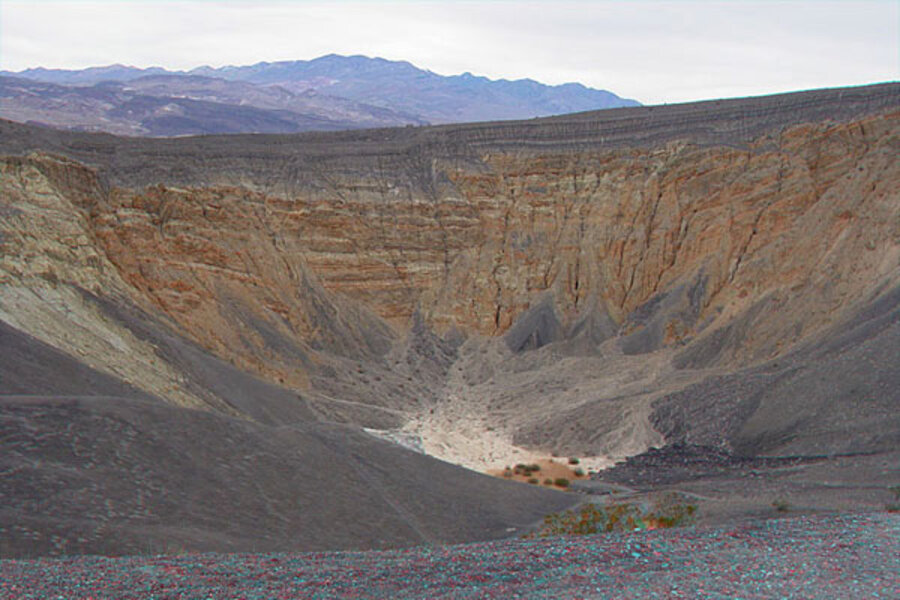In Death Valley, ancient volcano gives scientists a surprise
Loading...
A half-mile-wide crater in Death Valley National Park may represent a more significant volcanic hazard than previously thought, according to a new study – though not enough to cancel your next visit to the park.
The crater, Ubehebe, formed in an enormous explosion between 800 and 2,100 years ago, the research team estimates – far more recently than earlier studies suggest.
Moreover, the scientists involved in the work suggest the precursors for an eruption – a supply of magma and an underground source of water the magma could turn to steam in a flash – may still lurk beneath the nearly 800-foot deep crater.
"We were really surprised by the youthfulness of the eruption," says Brent Goerhing, a paleoclimatologist at Purdue University and a member of the team. "We always had in the back of our heads that it could be young, within the past few thousand years. But we didn't think it could be that young."
The results appear in the Jan. 18 issue of the journal Geophysical Review Letters.
Ubehebe is the largest in a grouping of small craters – all thought to have formed the same way: magma rising through the crust to encounter groundwater. The searing magma instantly turned the water to steam, blasting out the crust above it.
The steam and ejected rock would have risen in an expanding column, only to fall back to the valley floor once it ran out of energy to keep rising. The collapse would have sent a hot flow of material with a consistency of just-mixed concrete spreading in all directions at speeds up to 200 miles an hour. Larger rocks the blast lofted would have pummeled the ground.
The best spot for viewing the event would have been several miles away, Dr. Goehring quips.
Death Valley, with its parched climate, represents a prime location for studying the geological forces that shape the continent's basin-and-range region.
The region covers most of the US West, and is characterized by short, generally north-south trending mountain ranges separated by dry valleys.
Into Death Valley rode Goerhing, Columbia University professor Nicholas Christie-Blick, and a group of students in March 2008 on a field trip to use the valley as an outdoor teaching lab.
As the group walked along Ubehebe's rim, they talked about the crater's age and how it formed. How it formed "is pretty well-known," Goehring says. But estimates of its age ranged as far back as 20,000 years. Some researchers had found native American artifacts buried in the explosion's ash fall. That suggested Ubehebe's eruption came no earlier than 10,000 years ago, when humans are thought to have first moved into the valley.
At the time, Death Valley hosted a vast freshwater lake. The valley and the area around the lake would have held plenty of water for rising magma to flash-boil into steam.
The team estimates, however, that Ubehebe's eruption and that of smaller craters in the surrounding area could have started some 2,100 years ago and perhaps as recently as the 1300s – a span that included a prolonged period of extreme dryness in the Southwest, including Death Valley.
The new date range decoupled the eruption from a wet climate and sent the team looking for other sources of moisture.
The researchers used a technique based on the radioactive decay of beryllium-10 for dating rocks gathered from around Ubehebe in January and March of 2009.
Using previous estimates of the volume of rock ejected during Ubehebe's blast, the team calculated that it wouldn't take much magma – a blob no more than about 600 feet across – and a smaller volume of water to punch out Ubehebe's crater.
Such small deposits of groundwater could have survived the arid conditions at the time, and could well exist today, the team suggests. Based on the locations of springs in Death Valley today, the team estimates that groundwater may exist within about 500 feet of the crater floor.
A magma source today, however, may be a bit more difficult to pin down. Geophysicists trying to figure out what's underneath Death Valley have come up with conflicting evidence for the presence of liquid or semi-liquid magma.
In a study published last year, researchers from the University of Texas at El Paso used four independent lines of evidence to infer magma's presence. They estimate the magma is trapped some 15 miles below the valley floor.
The team, led by Musa Hussein, cautions that more work needs to be done to establish whether the magma there is molten or partially molten.
All of which says to Goehring and colleagues that while their results suggest the volcanic field Ubehebe occupies "may constitute a more significant hazard than generally appreciated," it's not time to dump annual park passes on unsuspecting eBay bidders.
"I'd hang on to them," he says of any park passes. Death Valley "is still worth going to."





